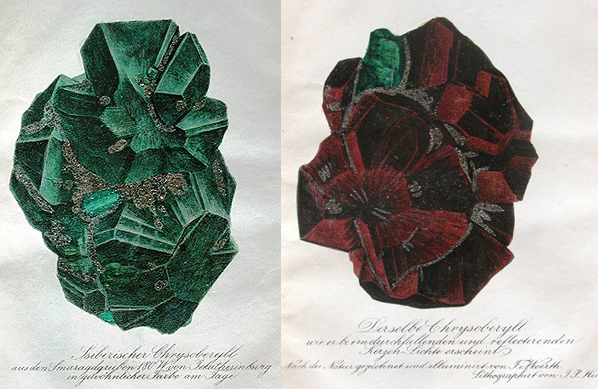 Images courtesy of Asbjørn Halvorsen Alexandrite: color change chrysoberyl. At left the crystal is depicted in daylight; incandescent or lamplight at right. Lithograph with applied mica powder. "Schriften der Russisch-Kaiserligen Geselschaft für die gesammte Mineralogie zu St. Petersburg", 1842. |
Alexandrite Chrysoberyl Some insights into the history of this color-change gem as told by Asbjørn Halvorsen (rough draft text - based on personal communication with Asbjørn, 2008 Of the publications describing alexandrite, the oldest I found was the first issue of "Schriften der Russisch-Kaiserligen Geselschaft für die gesammte Mineralogie zu St. Petersburg", from 1842. In this publication there is no division in chapters or sections, and it is somewhat difficult to find the start and the end of a description of a certain mineral, and who is the author. The description of Alexandrite, or Ural chrysoberyl, is found on pages 116 - 127, mostly with reference to Franz von Wörth, and assumedly he is the author. It is stated that the first chrysoberyl in the emerald mines in Wald district, 180 Werst from Jekhaterinburg, was found in 1833, see description in enclosed photograph 1. In the text shown in this photograph is also informed that von Wörth by measuring angles between the crystal faces found that this mineral was chrysoberyl. In this publication is also found two incredible illustrations of alexandrite crystal, in daylight and in lamplight, with assumed mica powder glued to the assumedly handcoloured lithographic picture, see enclosed photographs 2 and 3. Tests done by von Wörth, demonstrating colour change in solutions of chromium oxide in hydrochloric and sulphuric acid, are also described. It is stated that Nordenskjöld, Finnish mineralogist and explorer, later found the same properties in the Ural chrysoberyl, which he denoted alexandrite. This chrysoberyl had been first found on the day when the whole Russia celebrated the day of full age for Alexander Nicolajewitsch, heir to the Russian throne. Nils Nordenskiöld also remarked that red and green were the Russian military colours. His son Adolf seemed unable the share the same enthusiasm for the tsar and the Russian colours. In 1855, at age 23, he received his PhD in mineralogy. Two years later he made a strong patriotic speech that upset the Russian authorities, and was banished from Finland. He later became superintendent of the Mineralogical Department of the Swedish Royal Museum and conducted several arctic expeditions. Detailed descriptions of alexandrite were given in 1849 by Haidinger in "Ueber den Pleochroismus des Chrysoberylls" in Annalen der Physik und Chemie von Poggendorf, and in 1861 by Kokscharow in "Materialen zur Mineralogie Russlands" . Kokscharow stated that the name Alexandrite had been suggested by Nordenskjöld, and that alexandrite crystals from the emerald mines in Tokowaia had been studied in 1833 by von Wörth, secretary of the Kaiserligen Mineralogischen Gesellschaft zu St. Petersburg, who identified the mineral as chrysoberyl. Kokscharow gave Gustav Rose, later director of the Museum of Natural History in Berlin, the credit for the first comprehensive crystallographic study of alexandrite, described in 1842 in Volume 2 of the travel description "Mineralogisch-geognostische Reise nach dem Ural, dem Altai und dem Kaspische Meere" by Alexander von Humboldt and Gustav Rose. A new colour change mineral, chrome tourmaline from Ural, was described by Cossa and Arzruni in 1883. This tourmaline had also been studied by Gustav Rose, but according to Cossa and Arzruni he failed to observe the colour change behaviour: Two minerals that have been unknown till now deserve attention: a beautiful emerald-green chrome mica and a deep green chrome tourmaline. The latter was certainly seen, collected and described by G. Rose, but the true nature of this remained however hidden for this sharp observer. Prof. Websky recognised at the first glance that this mineral contained chrome. This was also confirmed by the observation of the beautiful dichroism, till now only known for alexandrite, and the pronounced partial transparency for certain parts of the spectrum. This property was especially clear by use of lamp light, these red rays were transmitted nearly unimpaired in the tourmaline, which appeared intense ruby-red. (translated from German). See also: Halvorsen, A. and Molesworth, H. (2007) Discovering and naming of alexandrite. Gems & Jewellery, vol. 16 no.1, pp.8-10. |
Back to Usambara Effect Home |